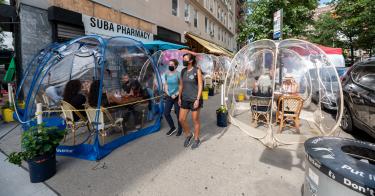One big factor keeping officials from reopening economies and schools—and ordinary citizens from resuming their normal lives—is uncertainty. We know that people can get COVID-19 and infect others—even if they don’t look or feel sick.
If we could determine who has the disease and who doesn’t, then those with COVID could stay home and the rest of us—especially those at lower risk—could go about our lives. Unfortunately, we haven’t had a quick and easy way to test for the presence of the disease. Until now.
A good screening test should be cheap, quick, easy to administer, sensitive, and broadly available. Last month, the FDA cleared a new rapid coronavirus test from Abbott Laboratories for use. It meets the first four criteria. Each test costs $5. It takes only 15 minutes to get results. It’s far more user-friendly. (You don’t have to stick the swab up your nose like earlier tests.) And it has a 97.1 percent sensitivity rate—much better than the “temperature check” screening methods that fail to capture the 54 percent of patients with no fever.
As for the fifth criterion, well, we’re making progress. Last week, President Donald Trump announced that the federal government had purchased 150 million of the rapid test kits, for distribution to states, tribes and other jurisdictions.
It’s a good start. To really capitalize on rapid tests, the president should take two more steps:
First, empower patients to conduct at-home tests. The tests require you to go to a medical professional for the test. Why? Especially when this test is so simple to perform. Earlier this summer, when Marie got a not-so-rapid COVID-19 test, she drove to a CVS and did her own test in the car—while someone watched through a window.
We can get and take home DNA tests—even fertility tests and food sensitivity tests, which involve drawing your own blood—all without in-person supervision of medical professionals. This should be no different.
The administration should modify the FDA’s emergency use authorization to allow home testing. At a minimum, the president should call for “telehealth” supervision of the testing.
Second, clarify who should take what test, when and why. After nine painful months of experience, we know that not everyone faces the same degree of risk of dying or complications from COVID-19. The elderly (people over 65 account for eight of every 10 U.S. virus-related deaths) and those with comorbidities are at highest risk. The risk for children is quite small.
The administration should rally every public health agency to publicize these facts and their implications for testing and other mitigation needs. This matters because, as the nation moves to deploy rapid tests as screening tools, it’s important that they go where they can do the most good.
Not every test is necessary for everyone in every situation. Screening tests serve a different public health purpose than diagnostic tests, which are meant to identify a specific pathogen in a sick individual. To date, due to limits in technology, we’ve essentially been using diagnostic tests as screening tests for screening purposes—a very inefficient use of these tests. But these new rapid tests are suited perfectly for a large variety of situations and scenarios.
A former CDC director, Dr. Brenda Fitzgerald, recently suggested that CDC clarify this way:
“Americans in long-term care or nursing homes must get regular, frequent testing.
“Those in a high-risk health category (diabetics or over 65, for example) should take extra precautions even in low-contact situations; namely, wear a mask or face shield and carefully social distance.
“For routine situations of possible contact (at grocery stores, for example) Americans don’t need a screening test if they feel well, but they should wear a mask or face covering, and wash hands or use hand sanitizer.
“Before a high-contact situation (e.g., on an airplane or in a theater), Americans should get a rapid screening test first to increase safety and reduce fear.”
Americans need this kind of clarity from our public health officials, so they can better assess their risks and their testing needs.
Clarity can dispel much of the uncertainty that has hindered the nation’s response to the pandemic. Trump said that the government purchased the rapid tests to “support efforts to reopen … economies and schools immediately and [as] fast as they can.” If he takes the two additional steps outlined above, he can help millions of Americans conquer the unfounded fear that is keeping them trapped in their pandemic bunkers.
This piece originally appeared in the Bangor Daily News



